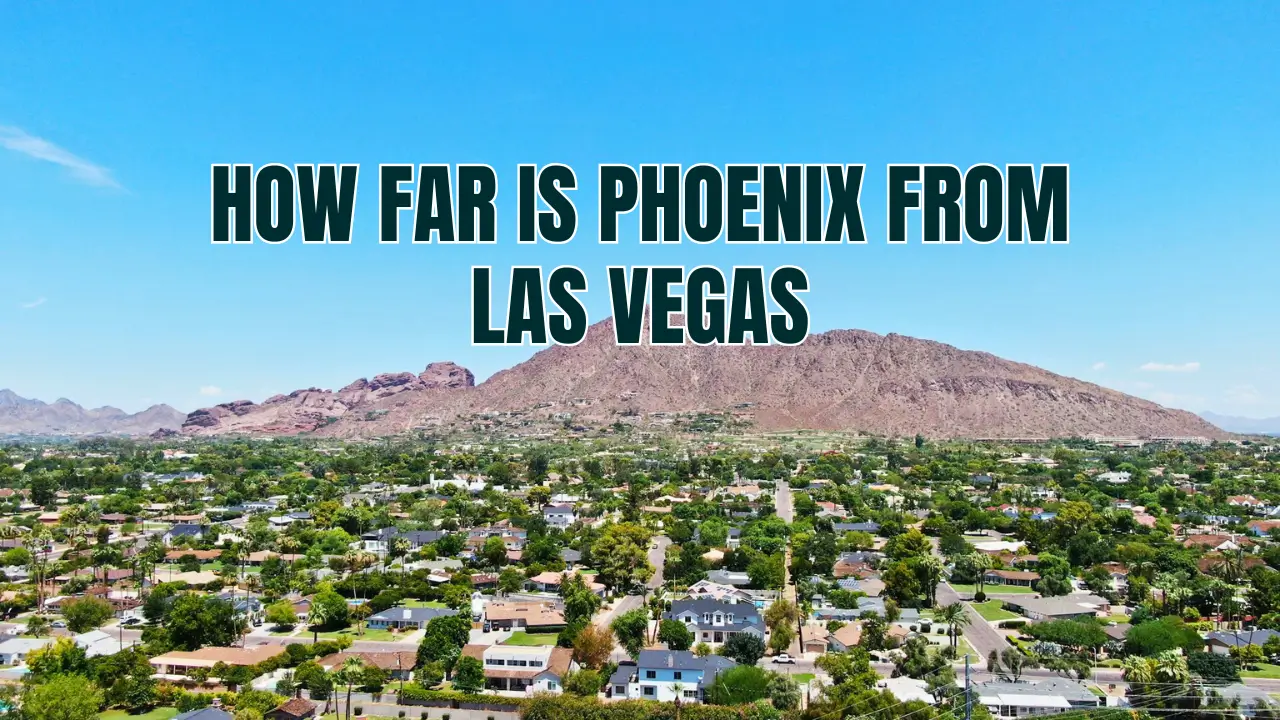Introduction
If you’ve ever stared at a map and wondered how far is Phoenix from Las Vegas, you’re not alone. These two major desert cities attract millions of tourists every year, and for good reason. Phoenix, known for its year-round sunshine and beautiful Sonoran Desert landscapes, is Arizona’s bustling capital. Las Vegas, on the other hand, is the entertainment capital of the world, famous for its neon lights, casinos, shows, and that irresistible glitz and glamour.
So why is the route between Phoenix and Las Vegas so popular? For starters, it’s a fairly short trip. Whether you’re looking for a quick weekend escape, a thrilling road trip, or just want to knock another state off your travel list, the Phoenix-to-Vegas route is ideal. You’ve got scenic desert highways, minimal traffic (most of the time), and plenty of quirky pit stops along the way. Plus, it’s incredibly flexible—you can fly, drive, or even take a bus.
In this article, we’re going to break down every detail you need to know about getting from Phoenix to Las Vegas. Whether you’re wondering about travel time, distance, the best route, or how much it’s going to cost, we’ve got you covered. We’ll also share travel tips, what to expect on the road, and how to make the most out of this journey. So buckle up, because your adventure through the desert starts here.
Flight Distance Between Phoenix and Las Vegas
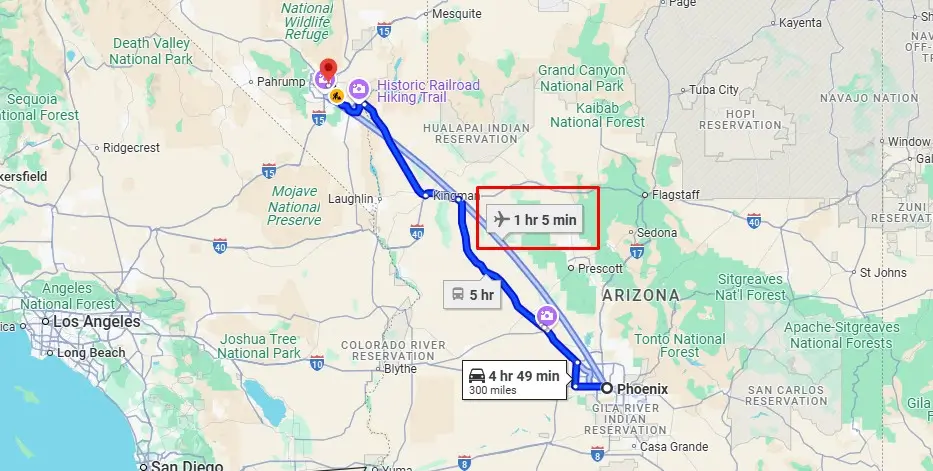
Image Credit: Google Map
Total Miles in a Straight Line
Let’s start with the basics: the straight-line distance, also called the “as-the-crow-flies” distance, between Phoenix and Las Vegas is roughly 255 to 256 miles (about 410–412 kilometers). This is important to note because if you’re flying, this is the distance your plane will cover, give or take a few miles based on routing and air traffic.
Why is this number smaller than the driving distance? Simple—roads twist, curve, and detour. Planes fly a more direct route, hence the reduced mileage. But keep in mind, the straight-line distance doesn’t reflect the time or hassle involved in air travel. You still have to factor in airport transfers, security checks, and boarding times.
Flight Time and Airlines That Operate This Route
The actual flight time from Phoenix Sky Harbor International Airport (PHX) to Las Vegas McCarran International Airport (now officially Harry Reid International Airport or LAS) is usually about 1 hour and 15 minutes. Some flights might be slightly shorter or longer, depending on the airline and wind conditions.
Several airlines operate direct flights between these two cities, including:
- Southwest Airlines – Known for affordable fares and free checked bags
- American Airlines – Offers frequent flights throughout the day
- Spirit Airlines – Budget option with bare-bones service
- Frontier Airlines – Another ultra-low-cost carrier
These flights are usually pretty frequent, especially on weekends and holidays when more people are traveling for leisure.
Airport Details: PHX vs LAS
- PHX (Phoenix Sky Harbor): Located about 3 miles from downtown Phoenix, it’s one of the busiest airports in the U.S. It has three terminals, efficient TSA checkpoints, and plenty of food and shopping options.
- LAS (Harry Reid International Airport): Just 5 miles from the Strip, this airport is surprisingly easy to navigate. It even has slot machines inside the terminals, so your Vegas experience starts the moment you land!
If you’re flying, both airports offer car rentals, shuttle services, and rideshare pickups—so transitioning from air to ground is usually pretty seamless.
Driving Distance from Phoenix to Las Vegas
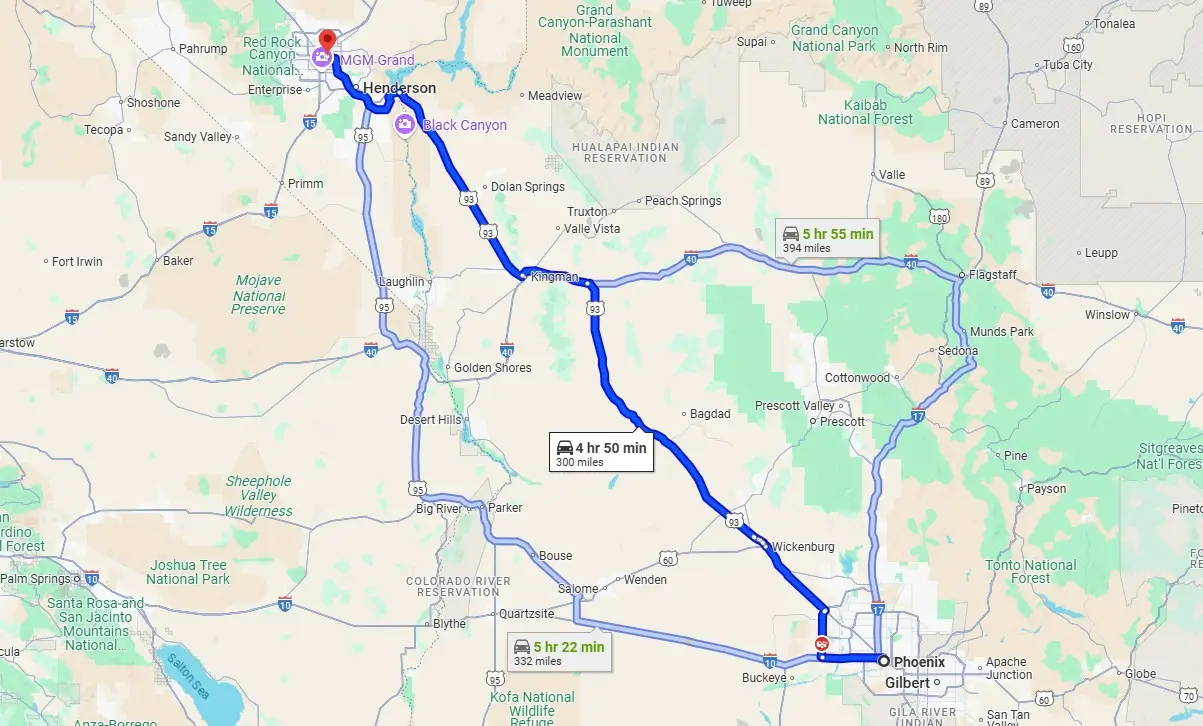
Image Credit: Google Map
Total Miles by Road
If you’re hitting the road, get ready for a 295 to 302-mile drive, depending on the route you take. This comes out to roughly 5 to 6 hours on the road. Sounds long? Not really. It’s actually one of the most scenic and manageable drives in the Southwest.
Why the variation in distance? It depends on whether you stick strictly to the main highways or take a few detours. Some people like to stop and explore along the way, which can add miles but also adds a lot of fun and adventure.
Most Popular Driving Routes (US-93 and I-11)
The main route most travelers use is:
- US-60 West → US-93 North → I-11 North → I-515 to Las Vegas
US-93 is a particularly notable stretch. Not only is it scenic, but it’s also been upgraded in recent years to support higher-speed travel and safety. I-11 is a newer highway project that connects parts of Arizona and Nevada, further improving travel times.
For those looking for a less conventional (but more scenic) route, try:
- AZ-74 West → US-60 West → US-93 North
This route gives you a chance to stop at places like Lake Mead or Hoover Dam—great photo ops and natural wonders.
Best Time to Drive for Least Traffic
You’ll want to avoid leaving Phoenix or Vegas during rush hours—especially Friday afternoons and Sunday evenings, which are peak travel times for weekenders. Early morning or late evening drives are usually less congested and can even provide some beautiful sunrise or sunset views over the desert.
Comparing Travel Modes
Flight vs. Driving: Which Is Faster?
When it comes to sheer speed, flying wins hands down. You’re in the air for just over an hour, and even with check-in and security, the total time can still be under 3 hours door-to-door. Driving, by contrast, takes anywhere from 5 to 6 hours on a good day.
However, if you live far from the airport or hate waiting in TSA lines, driving might be more appealing. It offers flexibility—you can leave when you want, make pit stops, and enjoy the scenic desert views. Flying saves time, but driving lets you take control of your trip.
Think of it this way: if you’re traveling light and want to maximize time in Vegas, hop on a plane. But if you’re looking for an experience, a road trip gives you stories to tell.
Cost Comparison
Cost is where things get interesting. Flying isn’t always the cheapest option unless you score a deal.
- Flights: Depending on the airline, season, and how early you book, a round-trip flight can cost anywhere from $60 to $300+.
- Driving: Let’s say your car gets 25 miles per gallon, and gas costs $4.00 per gallon. A round trip will cost you around $100 in fuel. Add snacks, possible hotel stays, or detours, and it could go up.
If you’re traveling solo, flying might be more cost-effective. But if you’re with friends or family, splitting gas makes the drive much cheaper per person.
Convenience and Comfort Factors
- Flying: Fast, comfortable (especially if you fly business or premium economy), and great for short notice. But you’re tied to airline schedules and airport logistics.
- Driving: Comfortable if you like your car and don’t mind long hours. More luggage space, flexible schedule, and the freedom to stop whenever you want.
Each mode of travel has pros and cons, so your choice really depends on your priorities—time vs money vs flexibility.
Road Trip from Phoenix to Las Vegas

Image Credit: Google Map
Must-See Stops Along the Way
One of the biggest perks of driving is that the journey becomes part of the adventure. Between Phoenix and Las Vegas, you’ll find several must-see stops:
- Wickenburg – A charming old western town with vintage shops and cowboy flair.
- Congress and Yarnell Hill – Steep, winding roads with panoramic desert views.
- Kingman, AZ – The gateway to Route 66 and home to fun diners and museums.
- Hackberry General Store – A quirky Route 66 icon.
- Hoover Dam – A jaw-dropping feat of engineering and a great photo op.
These stops aren’t just for sightseeing—they break up the drive, stretch your legs, and make the journey fly by.
Scenic Viewpoints and National Parks
There’s no shortage of desert beauty on this trip. Some spots worth pulling over for include:
- Lake Mead National Recreation Area – A peaceful spot for a quick hike or picnic.
- Mojave Desert landscapes – You’ll pass by some postcard-worthy scenes.
- Joshua Tree Forest (near US-93) – You’ll swear you’re in a Dr. Seuss book.
Bring your camera, because these views are unforgettable—especially around sunrise or sunset when the light dances across the rocks.
Ideal Playlist and Travel Snacks
No road trip is complete without a killer playlist. Mix some desert rock classics (think Eagles, Fleetwood Mac) with upbeat tunes and podcasts to keep things lively.
As for snacks? Go for easy, mess-free options like:
- Trail mix
- Beef jerky
- String cheese
- Grapes or apple slices
- Granola bars
Pro tip: bring a small cooler and plenty of water. It’s the desert, after all—you’ll thank yourself for staying hydrated.
Public Transport Options
Bus Services Available
Not a fan of driving or flying? Greyhound and FlixBus both offer bus services between Phoenix and Las Vegas. It’s slower—typically 6 to 7 hours—but cheaper, often under $50.
You’ll get free Wi-Fi, a bathroom on board, and sometimes USB chargers. If you’re not in a rush and want to save cash, this is a solid option.
Train Services (If Any)
Currently, there is no direct train service between Phoenix and Las Vegas. However, there have been talks about a high-speed rail line (Brightline West) connecting Las Vegas to California, and possibly extending service to Arizona in the future.
For now, Amtrak doesn’t serve this route directly—so if you’re hoping for a scenic train ride, you’re out of luck.
Rideshare and Shuttle Options
There are shuttle companies that operate between Phoenix and Las Vegas, often catering to tourists. These can be convenient if you’re traveling with a group or don’t want to deal with driving.
You can also look into long-distance rideshare apps like BlaBlaCar or ask in travel forums for carpooling options. Just be sure to vet the drivers and check reviews beforehand.
What to Expect on the Road
Weather Conditions
This is desert country, which means extreme heat in summer (often 100°F+), cooler evenings, and mild winters. Summer driving can be tough on your car, especially if your AC isn’t great. Always check the forecast before hitting the road.
Winter months are more comfortable, but evenings can get cold—especially in higher elevations around Kingman.
Watch for:
- Dust storms (usually in monsoon season: July–September)
- Flash floods in certain areas
- Wildfire smoke (occasionally in summer)
Gas Stations and Rest Stops
Thankfully, you’ll find plenty of gas stations on this route—especially in towns like Wickenburg, Kingman, and Boulder City. Just don’t push your luck by skipping fuel in the desert.
Rest areas are limited, so plan bathroom breaks in towns rather than relying on roadside pull-offs. Bring extra water, just in case.
Safety Tips for Desert Driving
- Keep a gallon of water in your car per person.
- Check tire pressure before leaving.
- Avoid driving at night if you’re unfamiliar with the area—it’s pitch black in parts.
- Cell service can be spotty, especially in remote stretches.
- Let someone know your route and expected arrival time.
With a little planning, this drive can be not only safe—but one of the most memorable you’ll ever take.
Travel Time Breakdown
Average Speed and How Long It Takes
Let’s break down the actual driving time between Phoenix and Las Vegas. Most people maintain an average speed of 60 to 75 miles per hour on this trip, depending on traffic and stops. Without any breaks, you can expect the journey to take around 5 hours and 30 minutes if you’re traveling at a steady pace.
However, when you add in a couple of bathroom or snack breaks, maybe a detour to Hoover Dam or a roadside diner, it’s more realistic to plan for 6 to 6.5 hours. Still, it’s a doable drive in a single day—no need to break it into multiple legs unless you want to take your time and sightsee.
Traffic Patterns by Day/Time
Traffic can drastically affect your travel time. Here’s a quick overview of when to expect more (or less) congestion:
- Friday afternoons: Heavy traffic leaving Phoenix
- Sunday evenings: Congestion heading back from Vegas
- Holidays and long weekends: Both directions are packed
- Weekdays (mid-morning or early afternoon): Ideal times to drive
If you want a smooth, stress-free drive, leave early in the morning—say, 6 or 7 AM. You’ll avoid traffic and catch stunning desert sunrise views.
How to Optimize Your Travel Time
Here are a few tips to make the most of your road trip:
- Use a real-time GPS app like Waze to avoid delays.
- Check Google Maps before departure for estimated traffic.
- Pack food and drinks to avoid extra stops.
- Fuel up in Phoenix to avoid higher gas prices in remote areas.
- Avoid rush hour in both cities.
Being strategic about timing can save you an hour or more on the road.
Cost of Travel
Fuel Cost Estimate
Let’s say your car gets around 25 miles per gallon. With a round trip of about 600 miles, you’ll need 24 gallons of fuel. At an average of $4.00 per gallon, your fuel cost would be around $96 for the entire trip.
If you’re driving a more fuel-efficient car (like a hybrid or EV), that cost goes down significantly. But if you’re in a truck or SUV, it could creep up toward $120–$140, depending on gas prices.
Also, don’t forget tolls (though they’re rare in this area), maintenance costs (like oil, tires, etc.), and the potential for overnight lodging.
Airline Ticket Average Price
Plane tickets can vary wildly. On average:
- Budget airlines: $40–$90 one-way if you book early
- Major carriers: $120–$250 round-trip
You’ll also need to factor in luggage fees, seat selection, airport parking or Uber rides, and possibly food or snacks at the airport. All in, a round-trip flight could cost $150–$300, depending on how you plan.
Rental Car vs. Own Car
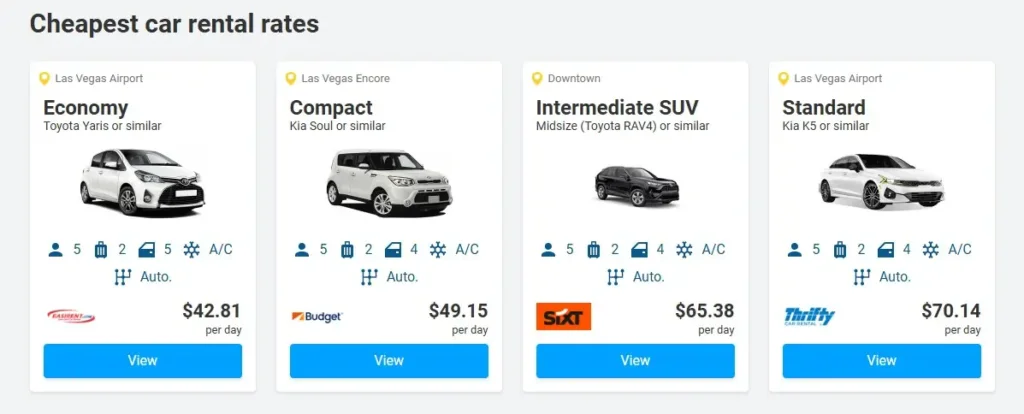
Image Credit: Discovercars
If you’re renting a car:
- Economy car: Around $40–$70 per day
- SUV or van: $70–$120 per day
That doesn’t include fuel, insurance, or extra fees. Renting might make sense if you want to preserve mileage on your own vehicle or need a larger car for a group. But for most travelers, using your own car will be cheaper—unless you get a killer deal on a rental.
Travel Tips
Best Time to Visit Both Cities
Want to enjoy perfect weather and avoid tourist mobs? Here’s when to go:
- Spring (March to May): Ideal temps, wildflowers, and outdoor activities.
- Fall (September to November): Slightly cooler than summer but still warm.
- Winter (December to February): Mild days and chilly nights—great for walking the Strip or exploring nature.
Avoid June through August unless you’re a fan of 110°F heat and crowded attractions. Summer is peak tourist season in Vegas, and Phoenix becomes a literal oven.
What to Pack
You’ll want to pack smart, especially if you’re hitting the road:
- Light, breathable clothing
- Sunglasses and a wide-brimmed hat
- Refillable water bottle
- Portable phone charger
- Sunscreen
- Car emergency kit (jumper cables, flashlight, tire gauge)
Even in winter, desert nights can get cold—so throw in a hoodie or light jacket just in case.
Things to Avoid
- Speeding on US-93: Lots of speed traps and occasional police stops.
- Ignoring gas levels: Always refill when you’re half full—stations can be far apart.
- Driving tired: The road is long and remote. Don’t push through fatigue.
- Drinking too little water: Dehydration is common in the dry desert air.
Being cautious and prepared can turn a stressful trip into an epic road adventure.
Las Vegas Arrival Tips
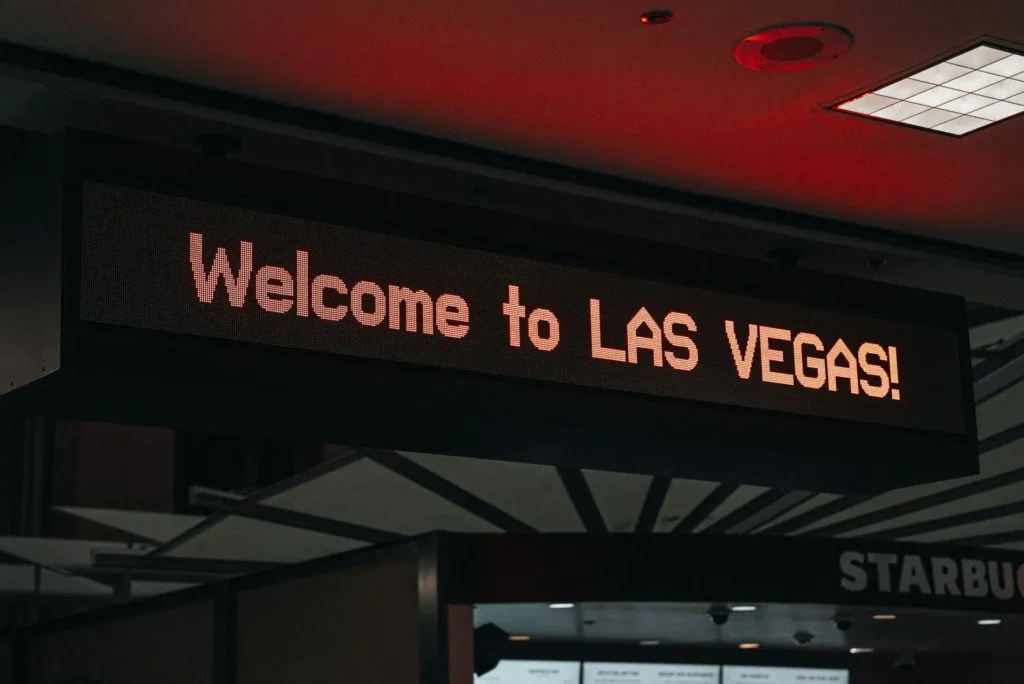
Image Credit: unsplash.com
Navigating from Airport to the Strip
Arriving by plane? The Las Vegas airport (Harry Reid International) is only 5 miles from the Strip. That’s about a 10-minute drive depending on traffic. You can:
- Grab a rideshare (Discovercars ,Uber or Lyft)
- Use a taxi (flat rate zones are available)
- Hop on a hotel shuttle (some are free with booking)
- Rent a car at the airport terminal
Most hotels have clear signage and pick-up zones, so getting where you need to go is super easy.
Where to Stay
From mega-resorts to budget motels, Vegas has it all:
- Luxury: The Venetian, Wynn, Bellagio
- Mid-range: The LINQ, Paris Las Vegas, Planet Hollywood
- Budget: Excalibur, Circus Circus, off-Strip motels
Prices can swing wildly based on time of year and events in town. Booking mid-week can save you hundreds compared to weekends.
Quick Local Tips
- Always carry small bills for tipping (valets, servers, casino staff)
- Stay hydrated—Vegas is dry!
- Don’t accept “free” nightclub passes from strangers on the street
- Use hotel room safes for your valuables
Vegas is fun, wild, and full of surprises—but being a smart traveler keeps your trip worry-free.
Phoenix Departure Tips
Airport Info and Parking
If you’re flying out of Phoenix Sky Harbor (PHX), it’s a pretty efficient airport with decent signage and fast-moving TSA lines.
- Parking: Economy lots cost about $10/day. There’s also valet and short-term parking closer to terminals.
- Ride-share: Uber/Lyft pick-up zones are well-marked and operate 24/7.
- Light rail: A cheap option if you’re near downtown Phoenix.
Arrive 1.5 to 2 hours early, especially during peak travel seasons.
Where to Eat Before You Go
There are some great eats inside PHX, including:
- Blanco Tacos + Tequila (Terminal 4)
- Matt’s Big Breakfast (Terminal 4)
- Wildflower Bread Company (Terminal 3)
Prefer to eat before you get to the airport? Try Pizzeria Bianco or The Vig nearby for a solid pre-flight meal.
Last-Minute Essentials
- Grab snacks and water at the airport (they’re pricey but convenient)
- Double-check your ID or passport
- Use apps like FlightAware or airline apps to track your flight status
Leave yourself a cushion of time—Phoenix traffic can be unpredictable, and airport lots can fill up fast on weekends.
Environmental Impact of Travel
Carbon Footprint of Flying vs Driving
Both travel methods have environmental costs. On average:
- Flying produces more CO₂ per person per mile—especially for short-haul flights like PHX-LAS.
- Driving, especially in fuel-efficient or electric vehicles, can reduce your carbon footprint.
If you’re traveling solo, the plane might still be greener. But driving with 2–3 passengers typically results in fewer emissions per person.
How to Offset Emissions
Want to travel greener? Consider these options:
- Purchase carbon offsets (many airlines offer this during booking)
- Drive a hybrid or electric car
- Pack light—more weight = more fuel consumption
- Reuse water bottles and avoid single-use plastics on the trip
Even small changes make a difference when you’re traveling frequently.
Local Laws and Driving Rules
Arizona vs Nevada Driving Laws
While the driving experience is similar in both states, here are some key differences:
- Speed limits: Arizona tends to be stricter; Nevada often posts 75 mph on highways.
- Cell phone use: Both states ban texting while driving; hands-free is the law.
- DUI laws: Strict in both states—never risk it.
Speed Limits and Checkpoints
Watch your speed—especially on US-93 near Kingman and Boulder City. Police presence is common, and speed traps are real. Also:
- Expect routine border agriculture checkpoints when re-entering Arizona
- Occasionally, sobriety checkpoints pop up near Vegas on weekends
Drive smart, stay safe, and you’ll be just fine.
Conclusion
So, how far is Phoenix from Las Vegas? Just enough to make it an epic getaway, but close enough to be super manageable. Whether you’re flying in for a wild weekend or cruising the desert highways for a scenic road trip, you’re in for a memorable journey.
This route offers more than just a destination. It’s filled with quirky stops, natural wonders, and opportunities to unwind, reflect, or just blast your favorite playlist. If you plan it right—watching your costs, prepping for the desert, and staying flexible—you’ll have an unforgettable travel experience.
FAQs
Q1: Can I drive from Phoenix to Vegas in a day?
Absolutely! It’s a 5–6 hour drive and totally doable in one day—just start early.
Q2: Is there a direct train between Phoenix and Las Vegas?
Nope. There’s no direct train yet, but there are bus and flight options.
Q3: Are there tolls between Phoenix and Vegas?
No tolls on the main route—US-93 and I-11 are toll-free.
Q4: What’s the cheapest way to get from Phoenix to Las Vegas?
Usually, taking a bus like FlixBus or Greyhound is the cheapest option.
Q5: Is it safe to drive from Phoenix to Las Vegas at night?
Yes, but the road can be dark and remote—watch for wildlife and keep your phone charged.

